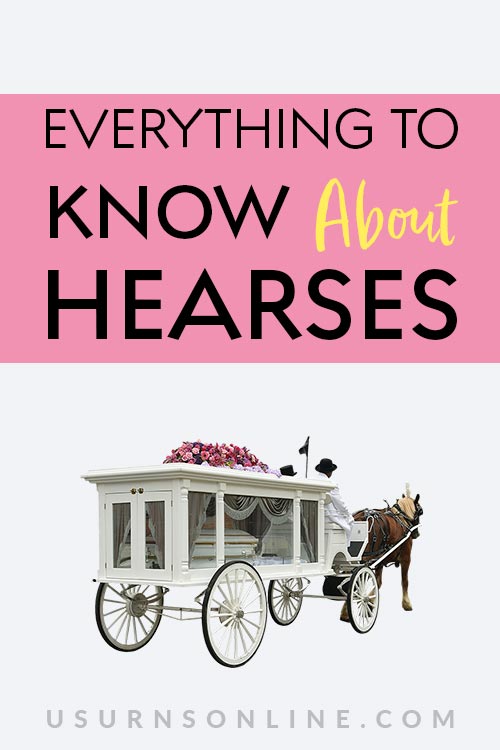Hearses are vehicles that take people for their final ride. That’s one of the the most straightforward answers we can give, anyway.
Everyone has questions about the death industry, and it’s perfectly natural to wonder about macabre curiosities (and sometimes practical necessities) such as hearses.
How many people can ride in a hearse? Do you have to “pay” for the use of a hearse? Do you have to have a special license to drive a hearse?
We’ve got the answers to all of these questions below, as well as some neat sections on the history of the hearse, fun facts, and a practical guide to using a hearse at a funeral.
What Is a Hearse?
A hearse is a vehicle used to carry the body of a deceased person in a casket to a funeral, wake, or memorial service.
The hearse also takes the casket to the cemetery or mausoleum after the memorial service.
How to pronounce hearse
Listen:
Hearse is pronounced like “her” with a soft “c” sound at the end:
hurce / hərs / herce
Hearse FAQs
Why is it called a hearse?
The term “hearse” comes from the old French herce, referring to the decorative candles placed on top of a coffin.
Urns Made in the USA
During the 17th century, the French word evolved to mean the wooden frame or box that stabilized the casket on funeral carriages.
Who can ride inside of a hearse?
Typically, it’s just hearse drivers and funeral directors — along with the casket — that ride inside of a hearse.
Why do hearses have curtains?
For the sake of privacy and reverence for the deceased, a hearse has curtains.
What are the things on the side of a hearse?
The decorative, S-shaped metallic bars seen on the rear panels of funeral cars are called landau bars.
The landau bar depicts the folding roof structure on of the Landau carriage, which was typically used before the invention of gas-powered hearses.
Since the mid-1940s, the landau-style hearse has been the most commonly used hearse in Western culture.
Do you have to rent a hearse for a funeral?
You don’t “have to” rent a hearse. If you or someone you know has a type of vehicle that can safely transport the casket, you can use that instead of the hearse.
A pick-up truck with a long enough bed works well. But, be mindful if you want to transport the body to the cemetery yourself, you’ll need to know your state’s laws on body transport.
You will also need to secure the necessary documentation and permits that you will need.
Bear in mind that a transporter’s license is necessary to transfer a body in a few states. This means that only a licensed funeral home staff will be able to complete the transport.
Can you use your own car as a hearse?
If you wanted to take your loved one’s casket to their final resting place yourself, it is allowed. Of course, your motor vehicle has to be big enough to accommodate the casket safely and securely.
Be sure to check your local and state laws on body transportation to ensure they allow for private funeral transportation to the burial site.
How much does a hearse cost for a funeral?
The average cost of the hearse is $175 to $400. Each of the funeral homes that I have worked for charged $350.
Can you rent a hearse for other events? Like a Halloween party?
You probably will not be able to rent a hearse from any reputable funeral home for a party.
There are special rental companies that have hearses for rent for parties and other fun activities. Just do an online search for your area, but understand that availability will vary.
How fast can a hearse go?
The fastest recorded speed for a hearse was the AMS Hearse “Madness” which clocked 161.4 miles per hour. But, please don’t try that at home!
A hearse usually drives as fast as a “normal” car.
Do hearses smell?
Hearses do not smell “like death” or have any bad odor in them at all.
What does a white hearse mean?
A white hearse is more modern than the traditional black hearse, which symbolizes mourning.
The funeral home that uses a white hearse stands out, but they are more rare to see. White also signifies a new life for the deceased.
What do you call a hearse driver?
A hearse driver is called a chauffeur or (wait for it)… a hearse driver.
What should you do when you see a hearse?
Always be considerate when you see a hearse. Here are the essentials to know:
- Be respectful.
- Yield the right of way.
- Never cut into a procession.
- Pull over and allow the procession to go by.
- Watch for the last driver in the procession.
Whether watching or participating, learn more about funeral procession etiquette here.
Can you get a horse-drawn hearse?
Yes, but they are not as common as they used to be and will be much more expensive than a contemporary vehicle hearse (usually somewhere in the $600-$1,000 range).
Do a quick web search for “horse-drawn hearses near me” to see what may be available in your area.
10+ Surprising Facts About Hearses
1. There are many hearse superstitions that people still believe.
Perhaps understandably, people can be very superstitious about death, funerals, and even hearses. You’ll still hear these things said:
- If you see a hearse, it means impending death for you or a loved one.
- Did you see your reflection in a hearse’s paint? Then you will die soon.
- Some people believe that seeing a hearse being pulled by two white horses means that someone in the neighborhood will die shortly.
2. Hearses are cleaned thoroughly between each use.
You are likely to never see a “dirty” hearse. Funeral homes are meticulous with all of their cleaning.
If you smell anything in a hearse, it is likely to be the pleasant smell of a cleanser or air freshener.
3. Hearses only carry one body at a time.
Because of the length and width of a casket, only one casket can fit in a funerary vehicle at a time.
4. No major American automobile manufacturer builds hearses at their factory.
Car manufacturers do not have a “hearse” division. Hearses are purpose built by companies that use the bodies of existing cars and customize them into the hearses you see today.
The largest manufacturer of hearses in the United States is Accubuilt, Inc., of Lima, Ohio. Accubuilt constructs 60 percent of the hearses in the USA, often under the S&S Superior Coach Company label.
5. There is a specific way the casket goes into a hearse.
A casket always goes into the rear of the vehicle “feet” first, so the body will have its feet pointed towards the front of the car.
6. Do you need a special license to drive a hearse?
Nope! You don’t need a special license to drive a hearse. Hearses only require a standard state-issued driver’s license.
Most funeral homes will require a high school diploma or GED, but these requirements may vary by state.
7. How much does a hearse cost to purchase?
The typical price tag on a hearse can run you around $30,000, though some high-end models can run over $60,000 while others can be in the low $20,000 range.
The world’s most expensive hearse, the Rolls Royce Phantom, carries a price tag of a cool 1.25 million.
8. A hearse has 4 doors… but only seats 2 people. Well, 3 people.
Hearses will seat two people, the driver, and one passenger. Due to the arrangement of the back section and how the hearses are altered post-production, the hearse has four doors, but only two seats.
And, of course, space for the casket.
9. Is there more than one name for a hearse?
Yes, hearses are also known as a funeral coaches or simply a coach.
10. How Long is a Hearse?
Hearses are generally around 20 feet long, though may vary by maker. Some, such as the Phantom model produced by Rolls-Royce, are as long as 23 feet.
11. Can I drive a hearse as a regular car?
Absolutely, you can. If you wish to purchase a hearse to use as your daily driver, go for it.
Just be aware that servicing and getting parts for them could be more difficult than a regular car. Also, driving a hearse could eat into your fuel budget, as they aren’t known for getting the greatest gas mileage.
History of the Funeral Hearse
When was the first hearse invented?
The first motorized hearses were built sometime in the early 1900s, when an undertaker commissioned a vehicle that combined the body of a funeral carriage and a bus chassis with a gas powered engine.
The idea quickly gained popularity and commercially built hearses were being manufactured by 1909.
Before motorized vehicles, horse-drawn carriages served as the original hearses. They were first officially chronicled in artwork in the15th century, though the concept most likely pre-dates this.
Even as far back as ancient times, “hearses” of sorts existed as hand-drawn carts.
The first manufactured hearse was made in Cincinnati.
The first company to mass-manufacture hearses was the Crane & Breed Company based in Cincinnati, Ohio.
The Crane & Breed Auto Hearse, as it was called, first made its debut on June 15th, 1909.
Henry the VIII and his extravagant hearses
As a monarch renown for his opulence, Henry VIII ordered to have four extravagant hearses built for his funerary procession, and to have them pulled by eight horses each.
They stood over fourteen feet tall, and were constructed of not wood, not metal, but wax! The wax allowed Tudor craftsman to carve intricate and elaborate architectural and ornamental designs into these temporary “portable palaces.”
Hearses worthy of note
The hearse has seen many, many incarnations over the centuries, and there are several notable examples that include:
The elaborate glass-paneled funeral carriages of the Victorian era.
The massive 1916 Packard Graveyard Bus, which could hold the coffin, pallbearers, and up to twenty mourners.
The hearses of the early 20th century, with their extravagant, carved wooden sides and elegant velvet draperies that were typical of craftsmanship among hearse manufacturers of the era.
If you’re interested in hearse history, consider visiting Barcelona’s Museum of Funeral Carriages, or the National Museum of Funeral History in Houston, TX to see some of the most beautiful and awe-inspiring hearses in the world.
A Practical Guide to Using a Hearse for the Funeral
Hearses are an integral part of planning a traditional funeral. Most people choose a hearse to lead the funeral procession — also known as a cortege — on the day of the funeral.
Since a hearse is a special vehicle and commands respect, people will usually stop and take notice of it as it passes by.
Technically, any vehicle that is large enough can be used to transport a casket to the place of burial, but a hearse is specifically built for that purpose. It’s the perfect size, the perfect height, and the easiest choice for casket transportation.
Not only that, but hearses are easily identifiable and are treated reverently by the public. They also convey a sense of somber dignity. Even if you are having a cremation burial, you can rent a hearse to transport the cremated remains.
The hearse is equipped to transfer the casket from the funeral home to the funeral service, then from the funeral service to the cemetery or mausoleum.
This is all included in the price of the rental from the funeral home. They provide the hearse, the driver, and everything involving transportation.
If you would like to give your loved one the dignity of a funeral procession led by a hearse, then this is a good and honorable choice.
If you discuss hearse rental and transportation with your funeral director, they will make sure to take care of you and anything you and your loved one need.
Well, there you have it! Now you know much more about hearses than you knew before, and the important role it plays in the funeral process.
Learn More: Funeral Planning Guide
Pin It






-Feet first. In an Emergency room/ Trauma center, the gurney is pushed ‘head first’ so Nurses can assess the patient and hook up monitors on the run, facing forward – not running backwards.
-Perhaps unloading the casket head first allows the awkward weight of the torso to be distributed to the pall bearers first, with the lighter foot end last.
-Old West slang has someone who’s not expected to survive an encounter or stubbornly refusing to leave a dangerous place as “leaving here feet first”.
-Feet first. In an Emergency room/ Trauma center, the gurney is pushed ‘head first’ so Nurses can assess the patient and hook up monitors on the run, facing forward – not running backwards.
-Perhaps unloading the casket head first allows the awkward weight of the torso to be distributed to the pall bearers first, with the lighter foot end last.
-Old West slang has someone who’s not expected to survive an encounter or stubbornly refusing to leave a dangerous place as “leaving here feet first”.
Why do hearses have such high, sloped roofs? I have seen caskets in hearses, and it’s not for clearance purposes, as there is plenty of space between the casket and the roof. I’ve always been curious, and have never found an answer online.